In today’s fast-paced digital world, aligning your marketing strategy with the right agency is more critical than ever. Many businesses face common challenges, such as wasted resources and missed opportunities, when trying to find the perfect marketing partner. These obstacles can hinder growth and prevent companies from reaching their full potential. This guide will help you navigate the process of finding the right marketing agency.
Understanding Your Needs
Before embarking on your search for a marketing agency, it’s essential to understand your own needs and objectives. Start by asking yourself key questions: Who is your target audience? What are your primary marketing objectives? What budget have you allocated for your marketing efforts? Clear answers to these questions will guide you in selecting an agency that aligns with your goals.
As well as understanding what your business needs, a data-driven approach to marketing strategy development is crucial. Data insights help in understanding customer behavior, preferences, and trends, which in turn inform your marketing decisions. Look for an agency that prioritizes data analytics and uses these insights to shape effective strategies. Our agency offers a range of services that cater to these considerations, including comprehensive audience research, targeted marketing campaigns, budget planning, and data analytics.
Evaluating Potential Agencies
Selecting the right marketing partner is an important decision that requires a thorough evaluation process. While online directories and review platforms are good starting points, they should not be your sole resource. Reviews can provide insights into an agency’s reputation, but a comprehensive evaluation is necessary for making an informed decision.
When evaluating potential agencies, delve deeper into their websites. Look for case studies that showcase results relevant to your industry and target audience. These case studies demonstrate the agency’s effectiveness and provide a clear picture of what you can expect. Additionally, explore the agency’s blog content to assess their thought leadership and expertise in specific marketing areas. A well-maintained blog indicates an agency’s commitment to staying updated with industry trends and sharing valuable insights.
Explore our marketing services →
Building a Collaborative Relationship
A successful marketing agency partnership is built on strong communication, collaboration, and client service. Start by crafting a list of questions to assess an agency’s approach to these aspects. How often will you meet? What communication channels will be used? Understanding their approach will help ensure a smooth working relationship.
Discuss the team structure and the specific people who will be working on your account. Building trust and ensuring expertise is crucial. Knowing the team members’ backgrounds and skills can give you confidence in their ability to deliver results. Additionally, inquire about reporting metrics and how the agency will measure success based on your defined goals. Transparency in results is vital. Regular, detailed reports help you track progress and make informed decisions.
Identifying Red Flags
When choosing a marketing agency, be aware of potential red flags that could indicate a poor fit. A lack of experience with your industry can be a significant concern. Ensure the agency has a proven track record in your sector to avoid any learning curve delays. Beware of agencies that emphasize vanity metrics like social media likes and impressions over meaningful results. A sustainable, organic SEO strategy should be the focus, aiming for long-term success rather than quick wins.
Be cautious of agencies that promise guaranteed rankings. SEO is a complex, ongoing process, and guaranteed results are unrealistic. The focus should be on sustainable growth and improved online visibility. Additionally, the dangers of hidden fees or lack of clear pricing structures can lead to unexpected costs. Our agency prides itself on a transparent pricing model, ensuring you know exactly what you’re paying for.
The Ideal Partnership: Achieving Long-Term Success
Effective communication, a collaborative approach, and clear reporting are crucial for a successful partnership. These elements help build trust and ensure both parties are aligned in their goals. Such a partnership leads to improved marketing ROI and sustainable growth. An agency that is deeply familiar with your brand can adapt strategies over time to meet evolving needs. At Tangible, we are dedicated to being that strategic partner for you, helping you navigate the complexities of marketing and driving your success.
Ready to take your marketing to the next level? Contact us today for a FREE SEO audit. Or, if you’re ready to move forward, schedule a free consultation to discuss your unique needs and discover how our team can help you achieve your goals.
In today’s digital age, having a strong online presence is crucial for healthcare organizations to attract patients and provide valuable information. Search Engine Optimization (SEO) ensures that healthcare websites rank high in search engine results, making them more visible to potential patients. This guide will explore the key strategies and best practices for implementing effective SEO in the healthcare industry.
Understanding Healthcare SEO Basics
Search Engine Optimization (SEO) is the process of optimizing a website to rank higher in search engine results pages (SERPs). For healthcare websites, this involves tailoring content and website structure to meet the specific needs of potential patients and search engines alike. Healthcare SEO focuses on making medical websites more accessible and relevant to users searching for health-related information. Here’s a general overview of the key parameters that search engines use to rank websites:
1. Relevant Content
Search engines prioritize websites that provide high-quality, relevant content. For healthcare websites, this means creating content that addresses the needs and concerns of patients. The content should be well-researched, accurate, and regularly updated to reflect the latest medical information. By focusing on relevant keywords and topics that potential patients are searching for, healthcare organizations can improve their rankings and attract more visitors.
2. User Experience and Technical Performance
A positive user experience (UX) and strong technical performance are critical factors in search engine rankings. Websites should be easy to navigate, load quickly, and be mobile-friendly. For healthcare sites, this includes having a clear layout, intuitive navigation, and responsive design that works well on all devices. Ensuring fast page load times and a seamless user experience can reduce bounce rates and increase the time users spend on the site, both of which positively impact rankings.
3. Authority and Credibility
Search engines also consider the authority and credibility of a website. This is often measured by the quality and quantity of backlinks from other reputable sites. Healthcare organizations can build authority by publishing valuable content, earning backlinks from trusted medical websites, and establishing partnerships with other reputable healthcare entities. Additionally, optimizing for local SEO by maintaining accurate and complete Google My Business profiles and appearing in local directories can enhance credibility and improve local search rankings.
The importance of SEO for healthcare organizations cannot be overstated. By improving online visibility, healthcare providers can attract more patients, build trust, and establish themselves as authorities in their field. This is especially important in a competitive industry where patients are increasingly turning to the Internet to find medical advice and services.
Keyword Research and Analysis for Healthcare
Effective SEO starts with thorough keyword research. Identifying relevant healthcare topics and queries helps you understand what potential patients are searching for. Use tools like Google Keyword Planner, SEMrush, and Ahrefs to discover high-volume keywords and trends related to your field.
Analyzing keyword trends and search volume informs your content strategy, ensuring that you create content that addresses common patient questions and needs. This not only improves your website’s visibility but also helps build trust with your audience by providing valuable information.
Optimizing Website Structure and Content
On-page SEO techniques are crucial for healthcare websites. These include:
- Meta Tags: Use relevant keywords in title tags, meta descriptions, and alt text for images to improve search engine visibility.
- Headers: Organize content with clear and descriptive headers (H1, H2, H3) to make it easier for search engines and users to navigate.
- Internal Linking: Link to related content within your website to improve navigation and keep users engaged.
Creating high-quality, informative content is also essential. Address patient needs and concerns by writing about common health issues, treatments, and preventive measures. This not only helps with SEO but also establishes your site as a reliable source of information.
Local SEO Strategies for Healthcare Practices
Local SEO is particularly important for healthcare providers, as many patients search for medical services within their area. Two key strategies for local SEO are:
- Optimize Your Google My Business Profile and Local Directory Listings: Ensure your practice’s name, address, phone number, and hours of operation are accurate and consistent across all platforms. Encourage satisfied patients to leave reviews.
- Target Local Keywords and Geotargeting for Location-Based Searches: Use location-specific keywords (e.g., “pediatrician in Greenville, SC”) and include your city or region in your website’s content and metadata.
Explore our digital marketing services →
Building Quality Backlinks and Authority
Backlinks are links from other websites to yours. They are crucial for SEO because they signal to search engines that your site is a credible source of information. To build quality backlinks:
- Earn Backlinks from Reputable Healthcare Websites and Authorities: Reach out to high-authority websites and propose guest posts or collaborations. Getting mentioned or linked by reputable sites enhances your site’s credibility.
- Establish Thought Leadership Through Guest Blogging and Expert Contributions: Write guest posts for reputable blogs in your field and contribute to industry publications. This not only builds backlinks but also establishes you as an authority in your niche.
Mobile Optimization and User Experience
A good user experience (UX) is critical for retaining visitors and improving SEO. With the increasing use of mobile devices, ensuring your website is mobile-friendly is paramount. Key strategies include:
- Ensuring Healthcare Websites are Mobile-Friendly and Responsive: Optimize your website design to work seamlessly on all devices. Use responsive design techniques to adjust content and layout based on screen size.
- Improving Page Load Speed and Navigation for Better User Experience: Optimize images and use efficient coding practices to reduce load times. Make navigation intuitive with clear menus and easy-to-find information.
Content Marketing and Patient Education
Strong content marketing involves creating educational content to address common health concerns and conditions. This helps position healthcare organizations as trusted sources of information. Examples of effective content marketing strategies include:
- Blogging: Regularly publish blog posts on relevant health topics, treatments, and preventive care tips.
- Videos: Create informative videos explaining medical procedures, treatments, and health tips.
- Infographics: Use visually appealing infographics to simplify complex medical information and make it more accessible.
Measuring SEO Performance and Analytics
Tracking key metrics is essential for evaluating your SEO efforts. Important metrics to monitor include:
- Organic Traffic: The number of visitors coming to your site from search engines.
- Keyword Rankings: The position of your targeted keywords in SERPs.
- Conversion Rates: The percentage of visitors who take a desired action, such as booking an appointment or filling out a contact form.
Use analytics data to assess the effectiveness of your SEO strategies and make informed adjustments. Regularly reviewing your performance helps ensure that your efforts are aligned with your goals and that you are continuously improving.
Partner with Tangible for Expert Healthcare SEO
Effective SEO is essential for healthcare organizations to increase online visibility, attract more patients, and provide valuable information to their communities. By implementing the strategies outlined in this guide, healthcare professionals can enhance their digital presence and better connect with patients in need of their services and expertise. If you need expert assistance with your healthcare SEO, contact our team at Tangible today and let us help you achieve your digital marketing goals.
In today’s digital landscape, Google Ads stands as one of the most powerful tools for driving targeted traffic to your business. However, simply running ads isn’t enough. To truly maximize your return on investment (ROI), you need to continuously optimize your campaigns. Effective optimization ensures your ads reach the right audience at the right time, leading to higher conversion rates and better overall performance.
In this guide, we’ll delve into key strategies for creating high-converting Google Ads campaigns that not only attract clicks but also convert those clicks into valuable customers.
Understanding Your Audience and Objectives
Knowing your audience is crucial for any marketing campaign, and Google Ads is no exception. Begin by identifying your target audience and creating detailed buyer personas. This involves understanding their demographics, interests, online behaviors, and pain points. Conduct thorough audience research and segmentation using tools like Google Analytics and Google Ads Audience Insights. Once you have a clear picture of who your ideal customers are, define your campaign objectives and key performance indicators (KPIs). Setting SMART goals—Specific, Measurable, Achievable, Relevant, and Time-bound—will help you stay focused and measure your campaign’s success accurately.
Keyword Research and Selection
Keywords are the foundation of any successful Google Ads campaign. Conduct thorough keyword research to discover the search terms your potential customers are using. Utilize tools such as Google Keyword Planner, SEMrush, and Ahrefs to gather insights on search volume, competition, and relevance.
Steps for effective keyword research:
- Use keyword research tools: Google Keyword Planner, SEMrush, and Ahrefs.
- Identify relevant keywords: Focus on high-intent, long-tail keywords.
- Analyze search volume and competition: Ensure the keywords are valuable and achievable.
- Select appropriate match types: Broad match, phrase match, exact match, broad match modifier.
- Use negative keywords: Exclude irrelevant searches to save budget.
Choose keywords that align with your campaign goals, focusing on long-tail keywords with high intent for conversions. Understand the different match types and use negative keywords to exclude irrelevant searches. This will help you avoid wasting your budget on unqualified clicks.
Explore our pay per click services →
Crafting Compelling Ad Copy
Your ad copy needs to be attention-grabbing and persuasive to stand out in the competitive Google Ads space. Write headlines that highlight your unique selling propositions (USPs) and the benefits of your product or service. Use clear and concise descriptions that encourage users to take action. Incorporate strong calls-to-action (CTAs) and offers to entice clicks. A/B testing different ad variations can help you determine which headlines, descriptions, and CTAs perform best. Analyze the performance of these elements to continuously optimize your ad copy for better results.
Optimizing Landing Pages for Conversions
A well-designed landing page is critical for converting clicks into customers. Ensure your landing page has a clear and compelling CTA that aligns with the messaging in your ads. The content on your landing page should match the promises made in your ad to provide a seamless user experience.
Key elements of a high-converting landing page:
- Clear CTA: Make it easy for users to take the desired action.
- Consistent messaging: Match ad promises with landing page content.
- Fast load speed: Optimize for quick loading times.
- Mobile responsiveness: Ensure the page works well on all devices.
Improve your page load speed and ensure it is mobile-responsive, as many users will access your site from mobile devices. A fast, user-friendly landing page reduces bounce rates and increases the likelihood of conversions.
Bid Strategies and Budget Management
Understanding and selecting the right bid strategies is essential for maximizing your Google Ads budget. Google Ads offers various bid strategies, including Manual CPC, Enhanced CPC, Target CPA, and Target ROAS. Choose the one that aligns with your campaign goals.
Steps for effective bid management:
- Select appropriate bid strategies: Manual CPC, Enhanced CPC, Target CPA, and Target ROAS.
- Adjust bids based on performance: Device, location, and audience segments.
- Monitor and manage spend: Regularly review budget allocation.
- Reallocate budget: Focus on high-performing campaigns.
Adjust your bids based on device performance, geographic location, and audience segments to ensure you are getting the best possible ROI. Monitor your spending and performance regularly, reallocating your budget to high-performing campaigns and adjusting bids as needed.
Ad Extensions and Enhanced Features
Ad extensions can significantly enhance the visibility and effectiveness of your ads. Utilize extensions such as sitelinks, callouts, and structured snippets to provide additional information and make your ads more informative and engaging. Explore enhanced features like Ad Customizers and Dynamic Search Ads to tailor your ads based on user intent and context. Personalizing your ads in this way increases their relevance and appeal to potential customers.
Ad Performance Monitoring and Optimization
Monitoring and analyzing ad performance is a continuous process. Track key metrics such as Click-Through Rate (CTR), Conversion Rate, Cost-Per-Click (CPC), and Return on Ad Spend (ROAS) using the Google Ads dashboard. Regularly review this data to identify trends, spot issues, and make informed optimization decisions.
Key metrics to track:
- Click-Through Rate (CTR): Measures the effectiveness of your ads.
- Conversion Rate: Indicates how many clicks result in conversions.
- Cost-Per-Click (CPC): Shows the average cost of each click.
- Return on Ad Spend (ROAS): Evaluates the profitability of your campaigns.
Adjust your bids, update ad copy, refine targeting, and test new keywords based on performance data to improve your campaign outcomes.
Campaign Targeting and Audience Segmentation
Refining your targeting options is key to reaching the right audience. Tailor your campaigns based on location, device, demographics, and interests. Segment your audience to create personalized campaigns that address the specific needs and preferences of different segments. Utilize remarketing and custom audiences to re-engage users who have previously interacted with your website or ads. This helps you reach potential customers at different stages of the buying journey, increasing the chances of conversion.
Testing and Experimentation for Continuous Improvement
Continuous testing and experimentation are essential for improving your Google Ads campaigns. Run split tests to compare different ad variations and landing page designs. Use the insights gained from these tests to iterate and refine your strategies.
Testing strategies include:
- A/B testing: Compare two versions to see which performs better.
- Multivariate testing: Test multiple elements simultaneously.
- Iterative testing: Make small changes based on test results.
Stay updated with industry trends and adjust your approach to ensure your campaigns remain effective and competitive.
Final Thoughts
Improving your Google Ads campaigns is an ongoing process that requires regular optimization and adaptation. By implementing the strategies outlined in this guide, you can enhance your ad performance, attract more qualified leads, and achieve higher conversion rates. Remember, the key to success is staying informed, testing new ideas, and making data-driven decisions. If you need expert assistance with your Google Ads campaigns, contact Tangible for a consultation, and let us help you achieve your marketing goals.
Small businesses play a vital role in the economy, but competing in today’s digital landscape can be challenging. Effective marketing strategies are essential for small businesses to stand out, attract customers, and achieve success. In this guide, we’ll explore actionable marketing strategies tailored specifically for small businesses to help them thrive in a competitive market.
Understanding the Importance of Marketing for Small Businesses
Marketing is the lifeline of small business growth. It is the engine that drives brand awareness, customer acquisition, and revenue generation. Strategic marketing is not just about selling products or services; it’s about creating meaningful connections with your audience. By investing in effective marketing strategies, small businesses can carve out a unique space in the market, differentiate themselves from competitors, and build lasting relationships with customers.
Defining Your Target Audience and Niche Market
Before diving into marketing tactics, it’s crucial to know who you’re targeting. Identifying your ideal customer profiles and buyer personas helps you tailor your marketing efforts to meet their specific needs and preferences. Narrowing down your target market allows you to focus your resources effectively and communicate more persuasively. Consider factors like demographics, interests, pain points, and buying behaviors to create a clear picture of your ideal customer.
Creating a Strong Brand Identity
Your brand identity is the face of your business. To develop a unique and memorable brand, focus on these three key areas:
- Voice: Establish a consistent and authentic tone that reflects your brand’s personality. Whether it’s friendly, professional, or humorous, your brand voice should resonate with your target audience.
- Logo: Design a distinctive and versatile logo that embodies your brand’s essence. A well-crafted logo can leave a lasting impression and enhance brand recognition.
- Visual Identity: Create a cohesive visual style, including color schemes, typography, and imagery, that aligns with your brand values. Consistency in visual elements across all marketing channels strengthens your brand presence.
Building an Online Presence
In the digital age, a strong online presence is non-negotiable. Start by developing a professional website with user-friendly navigation. Your website is often the first point of contact for potential customers, so make sure it is visually appealing, easy to navigate, and mobile-responsive. Utilize social media platforms to connect with customers, showcase your products or services, and engage in meaningful conversations. Platforms like Facebook, Instagram, and LinkedIn offer unique opportunities to reach different segments of your audience and build a community around your brand.
Implementing Content Marketing Strategies
Content is king when it comes to marketing. Creating high-quality content that educates and engages your audience can position your business as an authority in your industry. Focus on these three areas to demonstrate your expertise:
- Blogging: Regularly publish informative and valuable blog posts that address the needs and interests of your audience. Blogging helps improve your website’s SEO and drives organic traffic.
- Videos: Use video content to showcase your products, share customer testimonials, and provide educational insights. Videos are highly engaging and can significantly boost your online presence.
- Infographics: Create visually appealing infographics to present complex information in an easily digestible format. Infographics are great for sharing on social media and can enhance your content marketing efforts.
Utilizing Email Marketing for Customer Engagement
Email marketing is a powerful tool for nurturing relationships with your audience. Start by building an email list and segmenting subscribers based on their preferences and behaviors. This allows you to send personalized emails with valuable offers, updates, and news.
Personalization increases the relevance of your messages and enhances engagement rates. Use automated email campaigns to streamline your efforts and ensure timely communication with your subscribers.
Exploring Affordable Digital Advertising Options
Digital advertising offers small businesses an opportunity to reach a wider audience without breaking the bank. Consider these affordable options:
- Pay-Per-Click (PPC) Advertising: Run targeted ads on Google, Facebook, and Instagram to attract potential customers. PPC allows you to set a budget and only pay when someone clicks on your ad, making it a cost-effective option.
- Retargeting Campaigns: Re-engage potential customers who have shown interest in your products or services but haven’t yet converted. Retargeting ads can remind them of what they left behind and encourage them to complete their purchase.
Measuring Success and Iterating Strategies
Tracking and analyzing your marketing efforts is crucial for continuous improvement. Monitor these key metrics to gauge your success:
- Website Traffic: Keep an eye on the number of visitors to your site and identify which sources are driving the most traffic.
- Conversion Rates: Measure the percentage of visitors who take desired actions, such as making a purchase or signing up for a newsletter.
- Engagement Rates: Assess how your audience interacts with your content on social media and other platforms.
Analyzing these metrics helps you understand what works and what doesn’t, allowing you to make data-driven decisions and refine your strategies for better results.
Final Thoughts
Effective marketing is essential for small businesses to compete and succeed in today’s competitive landscape. By implementing the strategies outlined in this guide and staying adaptable in their approach, small businesses can attract customers, build brand loyalty, and achieve long-term growth and success.
For personalized assistance and expert guidance, our team at Tangible is here to help you navigate the ever-changing marketing landscape and achieve your business goals.
In the world of nonprofit fundraising, establishing and nurturing relationships with donors is paramount to achieving long-term success. Amidst the myriad of communication channels available, email marketing stands out as a powerful tool for engaging supporters, sharing impactful stories, and driving donations.
In this comprehensive guide, we’ll explore the intricate art of email marketing for nonprofits, unveiling strategies to cultivate donor relationships, enhance engagement, and drive meaningful impact.
Building Your Email List
A robust email list forms the foundation of successful nonprofit email marketing. Implementing opt-in strategies is crucial for acquiring subscribers who are genuinely interested in your cause. By creating compelling lead magnets and donation appeals, nonprofits can entice website visitors to subscribe to their email list. Utilizing website pop-ups and forms for email capture further facilitates the process, ensuring that every opportunity to connect with potential donors is maximized. Segmenting your email list based on engagement levels and interests allows for targeted communication, ensuring that recipients receive content that resonates with their specific interests and preferences.
Gathering the Right Information: Understanding Your Donors
Effective communication begins with understanding your audience. By gathering the right information about your donors, you can tailor your email communications to their interests, preferences, and giving behaviors. Tracking data such as demographics, past donation history, and engagement levels provides valuable insights into your donors’ motivations and interests. Utilizing tools such as surveys, donor profiles, and CRM systems allows nonprofits to collect and analyze data, enabling personalized and targeted communication that resonates with donors on a deeper level. Here are some key data points to collect:
- Name: Addressing donors by name adds a personal touch to your communications and fosters a sense of connection.
- Email Address: The cornerstone of your email list, capturing email addresses ensures direct communication with your supporters.
- Interests and Preferences: Understanding donors’ interests, causes they care about, and communication preferences enables tailored content delivery.
- Donation History: Tracking donors’ giving history allows for targeted appeals and personalized stewardship efforts.
- Engagement Levels: Monitoring donors’ engagement with your organization helps identify loyal supporters and potential advocates.
Growing a Donor Base: Making It Easy to Join
Making it easy for donors to join your email list is essential for growing your donor base and expanding your reach. Placing email signup forms prominently on your website, donation pages, and social media channels ensures that visitors can easily subscribe to receive updates and communications from your organization. Offering incentives such as exclusive content or event invitations can entice visitors to sign up for your email list. Additionally, leveraging partnerships, collaborations, and community events can help expand your reach and attract new supporters to join your donor community. By implementing these strategies, nonprofits can grow their donor base in a sustainable and ethical manner, fostering genuine connections with supporters who are passionate about their cause.
Crafting Compelling Email Content
Once you’ve built your email list, it’s time to craft compelling content that captivates and inspires your audience. By telling impactful stories of programs and beneficiaries, nonprofits can evoke emotions and foster a sense of connection with donors. Showcasing success stories and real-life impact through narrative adds authenticity and credibility to your message. Incorporating multimedia elements such as images, videos, and infographics enhances the visual appeal of your emails, making them more engaging and shareable. Providing program updates, milestones, and progress reports keeps donors informed and engaged, reinforcing their commitment to your cause.
Explore our email marketing services →
Personalization and Customization
Personalization plays a pivotal role in nonprofit email marketing, allowing organizations to tailor messaging to individual preferences and interests. Addressing donors by name and incorporating dynamic content and merge tags creates a personalized experience that resonates with recipients. Sending automated email campaigns based on donor behavior ensures timely and relevant communication, enhancing donor engagement and retention. Triggering emails for donation reminders, thank-yous, and impact updates reinforces donor relationships and encourages continued support.
Donation Appeals and Fundraising Campaigns
Effective donation appeal emails are essential for driving fundraising efforts and mobilizing support for impactful projects. Designing compelling donation appeals that highlight urgent needs and impactful projects captures donors’ attention and inspires action. Providing clear calls-to-action (CTAs) and donation buttons simplifies the donation process, making it easy for supporters to contribute to your cause. Planning and executing fundraising campaigns through email involves setting goals, timelines, and communication cadence to maximize impact and achieve fundraising objectives.
Here are some of the email campaigns every nonprofit should include.
Donation Appeals
Donation appeal campaigns are a vital component of nonprofit fundraising efforts. These campaigns are designed to encourage supporters to donate to specific fundraising initiatives or urgent needs. By effectively communicating the importance and impact of their contributions, donation appeal campaigns generate revenue to support nonprofit programs and initiatives. They mobilize donors to contribute to impactful projects and causes, driving the organization closer to its fundraising goals.
Program Impact Stories
Impact story campaigns play a crucial role in nonprofit storytelling and donor engagement. These campaigns involve sharing success stories, testimonials, and real-life examples of the nonprofit’s impact. By showcasing the tangible outcomes of their contributions, impact story campaigns inspire donors and reinforce their emotional connection to the organization and its mission. These stories demonstrate the transformative power of philanthropy and encourage continued support from donors.
Event Promotion
Event promotion campaigns are instrumental in driving attendance and participation in nonprofit events. These campaigns involve promoting fundraising events, community gatherings, and volunteer opportunities to supporters. By raising awareness and generating excitement about upcoming events, event promotion campaigns enhance community engagement and increase participation. They also help to spread the word about nonprofit initiatives and foster a sense of belonging among supporters.
Thank-You and Stewardship Campaigns
Thank-you and stewardship campaigns are a critical component of donor stewardship and retention efforts. These campaigns express gratitude to donors for their contributions and support. By acknowledging donors’ generosity and demonstrating appreciation for their impact, thank-you and stewardship campaigns cultivate donor loyalty and strengthen relationships with supporters. They create a culture of appreciation within the organization and encourage continued engagement and support from donors.
Engagement and Retention Strategies
Beyond soliciting donations, nonprofit email marketing plays a crucial role in fostering donor engagement and retention. Encouraging donor engagement through surveys and feedback requests invites donors to share their thoughts and opinions, strengthening their connection to your organization. Implementing donor recognition and appreciation efforts, such as personalized thank-you emails and certificates, acknowledges donors’ contributions and celebrates their impact. By celebrating milestones and achievements with the donor community, nonprofits can foster a sense of belonging and community among supporters.
Measuring and Analyzing Email Performance
Measuring the performance of email campaigns is essential for optimizing strategies and driving continuous improvement. Tracking key metrics such as open rates, click-through rates, and conversion rates provides valuable insights into campaign effectiveness and donor engagement. Analyzing engagement data allows nonprofits to identify trends, preferences, and areas for improvement, guiding future email content and strategy. Utilizing A/B testing to experiment with different email elements enables organizations to refine their approach and maximize the impact of their email marketing efforts.
Nurturing Donor Relationships Through Email
Email marketing serves as a powerful tool for nonprofits to cultivate donor relationships, enhance engagement, and drive meaningful impact. By leveraging storytelling, personalization, and strategic communication, organizations can connect with supporters on a deeper level, inspiring them to make a difference and become lifelong advocates for their cause. As nonprofits continue to adapt and innovate their email strategies, they have the opportunity to forge stronger connections with donors and create lasting change in the world.
If your nonprofit organization is looking to enhance its email marketing efforts and strengthen donor relationships, our team at Tangible is here to help! Contact us today for expert guidance and support tailored to your nonprofit’s unique needs.
In the dynamic landscape of the legal industry, effective marketing strategies are paramount for law firms looking to stand out, attract clients, and ultimately thrive in a competitive market. At the heart of this endeavor lies lead generation—the lifeblood of any successful law practice.
Lead generation is more than just acquiring contact information; it’s about nurturing relationships and guiding potential clients through their decision-making journey. In the legal realm, where trust and credibility are paramount, generating leads becomes not only a necessity but a strategic imperative.
Now, more than ever, law firms must harness the power of strategic marketing to distinguish themselves from the competition. With the rapid increase of digital channels and the ever-evolving preferences of consumers, the ability to craft compelling marketing strategies has become required.
Ok, so you’re convinced, but what do you do now? Well buckle up because we’re about to dive into the ultimate guide to generating leads in the legal world!
Understanding Your Target Audience
One of the first steps in developing a successful law firm marketing strategy is understanding your target audience. This involves identifying your ideal clients, understanding their specific needs and pain points, and conducting market research to gain insights into the legal needs of your target market. By understanding your audience, you can tailor your marketing efforts to better resonate with their interests and preferences.
Building a Strong Online Presence
Now that you’ve identified your ideal clients and their specific needs, it’s time to put that knowledge into action and build a strong online presence that speaks directly to your target audience. A professional and user-friendly website is the cornerstone of any successful marketing strategy for law firms. Your website serves as your digital storefront and is often the first impression potential clients will have of your firm. It’s important to invest in website design and navigation, incorporating clear calls-to-action (CTAs) for lead capture, and creating compelling content that showcases your expertise and addresses the needs of your audience.
If you mentally just checked this off your “to-do” list because you already have a website, answer this question first before you move on: when was your website created, and when was it last time updated? If you have an outdated website, it can do more harm than good, potentially deterring potential clients and hindering your firm’s growth. It is like a legal document written in Comic Sans—it’s just not going to be taken seriously. Here are some things we often see on legal websites:
- Obsolete Design: An outdated design that looks unprofessional and fails to reflect your firm’s brand identity.
- Poor Navigation: Confusing navigation and a lack of user-friendly features make it difficult for visitors to find the information they need.
- Slow Loading Times: Slow loading times due to outdated technology or excessive use of large files and images.
- Lack of Mobile Responsiveness: Failure to adapt to different screen sizes, resulting in a poor user experience on mobile devices.
- Limited SEO Optimization: Insufficient optimization for search engines makes it challenging for potential clients to find your website in search engine results.
A good website serves as a powerful marketing tool for your law firm, and the last thing you want to do is harm your firm’s credibility with an outdated website. Here’s what you should be looking for on your website:
- Mobile Responsiveness: A responsive design that adapts seamlessly to different screen sizes, ensuring a consistent and user-friendly experience across all devices.
- SEO Optimization: Optimization of code and content for search engines, making it easy for search engine crawlers to index and rank your site in search results.
- Engaging Content: Dynamic content keeps visitors interested and encourages them to explore your site further. This includes informative blog posts, case studies, and client testimonials.
- Clear Calls-to-Action: Clear calls-to-action that guide visitors towards taking the desired action, whether it’s scheduling a consultation, downloading a resource, or contacting your firm.
- Intuitive Navigation: Easy-to-navigate layout with intuitive navigation menus and clear pathways to key information and services.
- Regular Updates: Regular updates and fresh content that keep your website relevant and up-to-date with the latest industry trends and developments.
By investing in a well-designed and optimized website, your law firm can establish a strong online presence, attract more potential clients, and, ultimately, grow your practice. Whether you’re revamping an outdated website or creating a new one from scratch, prioritizing these characteristics will set your firm up for success in the digital age.
Explore our custom website services →
Search Engine Optimization (SEO) Strategies
If you have a good online presence, don’t leave it at that. Your next move is to boost visibility and attract organic traffic through effective SEO. In the competitive landscape of online search, ensuring that your law firm is discoverable to potential clients is paramount. Think of SEO as your law firm’s secret weapon – the Batman to your Robin, the peanut butter to your jelly, the… you get the idea. Search Engine Optimization (SEO) is the key to achieving visibility in search engine results pages (SERPs) and attracting organic traffic to your website. Let’s explore some essential SEO strategies to help your law firm rise to the top:
Optimizing Your Website for Relevant Keywords and Phrases
Keyword optimization involves identifying the terms and phrases potential clients use when searching for legal services and strategically incorporating them into your website’s content. This includes optimizing page titles, meta descriptions, headers, and body content to align with your target keywords. By targeting the right keywords, you can increase your website’s relevance and visibility in search results, driving more qualified traffic to your site.
Conducting Keyword Research for Legal Services
Keyword research is the foundation of any successful SEO strategy. By conducting thorough keyword research, you can gain insights into the specific terms and topics relevant to your practice areas and target audience. This allows you to tailor your content and optimization efforts to attract the right audience and improve your website’s visibility in search results.
Implementing On-Page SEO Techniques
On-page SEO techniques involve optimizing various elements of your website to improve its visibility and relevance in search results. This includes optimizing meta tags, headers, images, and URLs to include relevant keywords and provide clear signals to search engines about the content of your pages. Additionally, optimizing page load speed, mobile-friendliness, and user experience are crucial factors that can impact your website’s SEO performance.
Building Quality Backlinks from Legal Directories, Associations, and Publications
Backlinks are a crucial component of SEO, serving as votes of confidence from other websites that vouch for the quality and authority of your content. Building quality backlinks from reputable sources such as legal directories, associations, and publications can significantly impact your website’s search rankings. By earning backlinks from authoritative websites within the legal industry, you can improve your website’s authority and credibility in the eyes of search engines, leading to higher rankings and increased organic traffic.
Optimizing Your Google My Business Listing
Google My Business (GMB) is a powerful tool for local SEO, allowing law firms to manage their online presence and appear in local search results. Optimizing your GMB listing involves providing accurate and up-to-date information about your firm, including your name, address, phone number, and business hours. Additionally, optimizing your GMB listing with relevant keywords, categories, and photos can improve your visibility in local search results and attract potential clients in your area.
Remember, when it comes to SEO, it’s not about tricking the search engines – it’s about playing by their rules and winning the game fair and square. By implementing these SEO strategies, your law firm can improve its visibility in search engine results pages (SERPs) and attract more qualified traffic to your website. With a solid SEO foundation in place, you can position your firm as a trusted authority in your practice areas and drive growth for your business.
Utilizing Pay-Per-Click (PPC) Advertising
PPC advertising is another effective strategy for law firms to attract qualified leads and drive website traffic. But what exactly is PPC advertising? In simple terms, it’s a digital marketing strategy where advertisers pay a fee each time their ad is clicked. This allows you to place your ads in front of a highly targeted audience who are actively searching for legal services, increasing the likelihood of generating leads for your law firm.
For PPC ads to be effective, it’s crucial to select the right keywords that align with the search intent of your target audience. This involves conducting thorough keyword research to identify relevant terms and phrases that potential clients are likely to use when searching for legal services.
In addition to selecting the right keywords, organizing them into campaigns and ad groups is essential for ensuring your ads are displayed to the right audience at the right time. Campaigns allow you to group together related ads and keywords, while ad groups further refine your targeting based on specific themes or topics.
However, PPC advertising doesn’t end with keyword selection and organization. To maximize the effectiveness of your ads, you also need to have landing pages set up that capture the interest of your leads and encourage them to take action. Landing pages should be optimized for conversions, with clear calls-to-action and compelling messaging that aligns with the ad they clicked on.
With careful planning and execution, PPC advertising can be a highly effective strategy for generating leads and driving growth for your law firm. By selecting the right keywords, organizing them into campaigns and ad groups, and creating compelling landing pages, you can attract high-quality leads and maximize your return on investment.
Explore our pay per click advertising services →
Engaging with Social Media
Social media platforms offer law firms an opportunity to engage with their audience, share valuable insights and updates, and build relationships with potential clients. Establishing a presence on relevant platforms such as LinkedIn, Facebook, and X helps you actively engage with your followers, increasing brand awareness, driving website traffic, and ultimately generating leads.
Some ways you can accomplish this is by sharing content on social media that:
- Provides Legal Insights: Give your audience valuable insights into legal topics relevant to your practice areas. Share tips, best practices, and industry trends to position your firm as a thought leader in your field.
- Answers Frequently Asked Legal Questions: Address common legal questions and concerns that your audience may have. By providing helpful and informative answers, you can demonstrate your expertise and build trust with your followers.
- Provides News Updates: Keep your audience informed about the latest news and developments in the legal world. Share updates on legislative changes, landmark court cases, and other relevant news stories to keep your followers engaged and informed.
On social media, it’s not about who shouts the loudest—it’s about who tells the most compelling story. By consistently sharing relevant content and engaging with your audience on social media, you can strengthen your firm’s online presence and attract new clients to your practice.
Explore our social media services →
Tracking and Analyzing Results
Tracking key performance indicators (KPIs) and analyzing results is essential for evaluating the effectiveness of your marketing efforts and making data-driven decisions. Tracking KPIs such as website traffic, conversion rates, and form submissions allows you to gauge the effectiveness of your lead generation efforts. By analyzing these metrics over time, you can identify trends and patterns in your lead generation performance. For example, if you notice a decrease in website traffic or a drop in conversion rates, it may indicate that your marketing strategy needs adjustment. Conversely, if you see an increase in form submissions or a rise in qualified leads, it suggests that your efforts are paying off.
Final Thoughts
Trying to navigate the legal landscape without a solid marketing strategy is like trying to find a needle in a haystack—without the haystack. Without it, your firm will miss out on the huge potential to generate leads, attract clients, and grow your business. Consistent efforts and adaptation to market changes are key to long-term success. Remember, the journey to lead generation is ongoing, but with the right strategies in place, your law firm can thrive and achieve its goals.
Ready to take your law firm’s marketing efforts to the next level? Our team of experts at Tangible specializes in crafting tailored marketing solutions for law firms just like yours. Whether you’re looking to enhance your online presence, boost lead generation, or optimize your digital marketing strategy, we’re here to help. Contact us today to schedule a consultation and discover how we can elevate your law firm’s marketing game!
The world of web analytics is vast and profound, with many acronyms, statistics, and confusing metrics that are exceptionally hard to decipher.

And Google Analytics is certainly no exception, especially with the most recent release of Google Analytics 4.
Just when you thought you kind of sort of had some things figured out in Google Analytics, they throw a wrench at you with the recent release of GA4. And there are a lot of changes to unpack.

So, if you’re feeling a bit lost, first of all, take a deep breath because you’re not alone. Sit back, relax, and read up as we explain the most important new features for you and reveal exactly how you can harness their power to grow your business.
What Changed in Google Analytics 4?

GA4 was designed to have a higher degree of flexibility, improved graphics, and more robust features than its predecessor. The biggest change is how GA4 interacts with and collects data in comparison to Universal Analytics (UA).
Universal Analytics uses a slightly different collection method than GA4 does. While UA typically measures and reports statistics based on user sessions and pageviews, GA4 categorizes every user interaction as a separate event, be it page views, conversions, or clicks.
So what does that mean in the overall gist of things? Well, consider that you threw a massive party in the Hollywood Hills. Rather than reporting on the total number of visitors who came to your party, purchased your alcohol, or left before stepping foot into your house, you could track where a user went over the course of the night, what that user purchased, and which demographic they belonged to.

So, in terms of GA4, this means that GA4 statistics are considerably more focused on the user journey as opposed to the overall page visitors. Thus, you’re able to more accurately track users who engage in different activities on your website, as opposed to just the total users.
The Most Important GA4 Metrics to Pay Attention To
Metrics are quantitative statistics used to measure a user’s activity during a browsing session on your website. This occurs from the second they enter your site to the minute they leave or remain inactive for 30 minutes or more. Most of the key metrics from UA were migrated over to GA4, but there are some new updates and changes worth explaining.
Let’s review the key statistics and updates you should utilize in GA4.
Engagement Rate
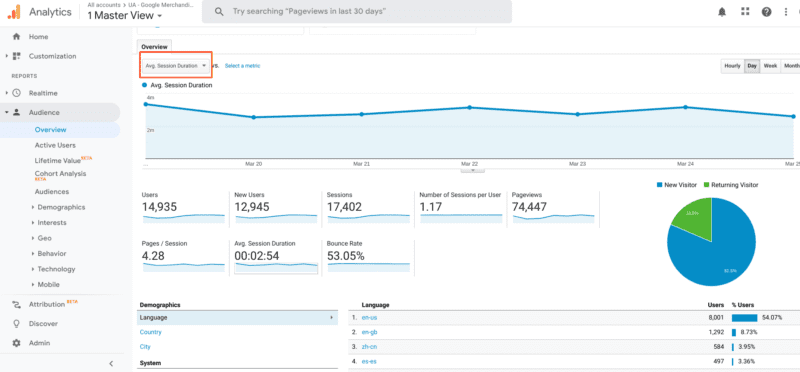
What It Is: An engaged session is considered to be any user session that lasts for at least 10 seconds, includes two different page views, and has 1 conversion event (which is a user completing a desired action such as subscribing to a newsletter, purchasing an item, etc.).
What it Means: Essentially, engagement rate is a measure of your audience’s interaction with your content. A low engagement rate isn’t a good sign and is usually a strong indicator that something about your page isn’t resonating with your audience.
Tip: Consider reevaluating your UX, copy, and/or graphic design to encourage a design that is more conducive to your site’s conversion goals.
Conversion Rate
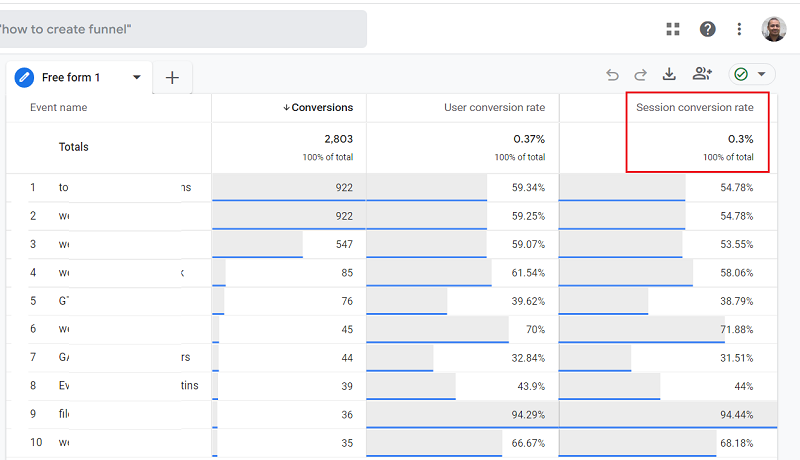
What It Is: The conversion rate is the ratio of users who complete a desired action (i.e., making a purchase, booking an event, signing up for your email newsletter) on your website. GA4 allows you to specify which conversion event you wish to measure, making it easier than ever to measure the results of specific campaigns.
What It Means: Conversion rate measures the overall ROI of your marketing efforts and provides critical insight into the effectiveness of your website as a whole. It gives you a direct peek into how well specific aspects of your website function and can help you understand which user flows may need revising.
Tip: If certain conversion events have a lower conversion rate, consider revising the call to action. Simple A/B testing of your CTA can prove exceptionally valuable in determining the clarity of your messaging.
Acquisition Source
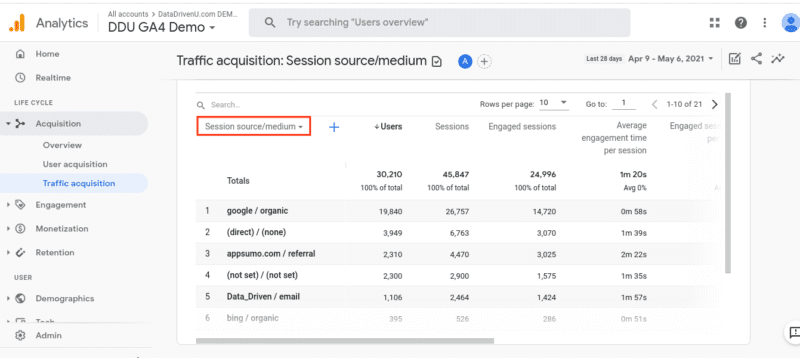
What It Is: Acquisition source, as the name implies, measures where your website’s visitors were acquired. This can include things like social media sources, search engines, or direct traffic. By accessing site backlinks and tracking, Google Analytics is able to determine where each user came from before making their way to your website.
What It Means: By understanding which channels are directing the most traffic to your site, you can further concentrate your targeted efforts with those channels and boost marketing efforts in all of the right places.
Tip: Consider dropping any paid acquisition sources with subpar results and concentrating those efforts elsewhere. Influencer marketing and organic advertising may provide better results.
Events
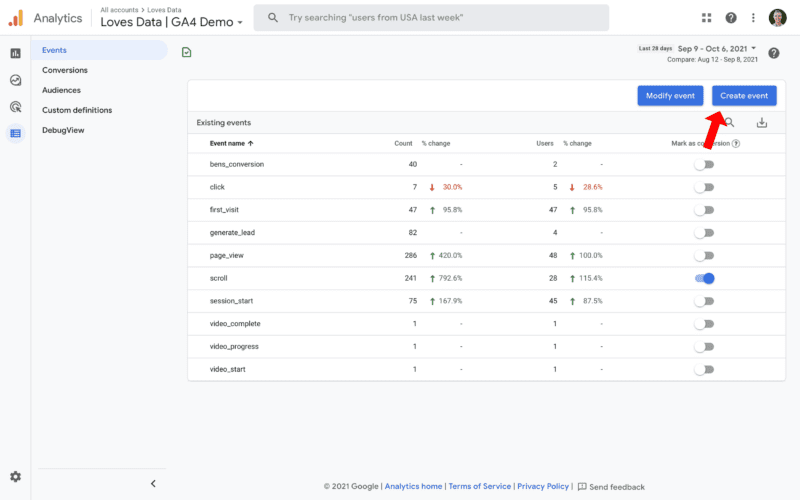
What It Is: In GA4, events can be any action that you wish to be tracked (aside from page views). This can include things like form downloads, button clicks, or video plays. Essentially, with the update to GA4, anything and everything is considered an event. There are four particular types of events that are important to distinguish, including:
- Recommended Events– Recommended events can be found in your standard reports and are typically only used when you run a specific type of event like a purchase or generate_lead event.
- Enhanced Measurement Events– These types of events don’t need extra coding changes and can be found when enhanced measurement is allowed for web data streams.
- Automatically Collected Events– As long as you have GA4 installed, these types of events are collected by default.
- Custom Events– Custom events will not show up in your standard reports unless you define them. However, additional measures will still need to be taken to extract meaning from their reports, such as custom explorations or reports.
What It Means: Events allow you to discover which elements your site users interact with most and which aren’t as successful. This enables you to better optimize your site to improve user conversions.
Tip: If certain events generate poor results, then it’s time to do a full-scale analysis of your user flow and UX design. Perhaps users are having trouble finding certain buttons or are unsure of their purpose. Consider running user surveys to find out where potential trouble spots and frustrations are happening so that you can better optimize your site.
Sessions Per User
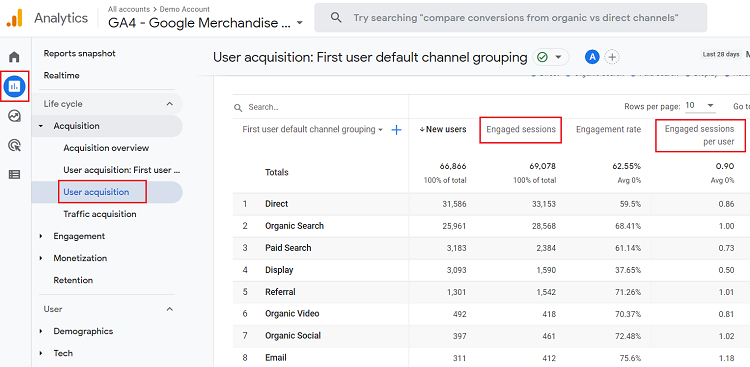
What It Is: In a nutshell, this metric quantifies how often users return to your website. It’s a measurement of the average number of unique visits a person makes within a certain time period and is calculated by dividing a website’s total sessions by the number of users.
What It Means: Sessions per user are a valuable tool for gauging brand loyalty. If customers are continually returning to your website, then it means they’re interested in your products, mission, or overall messaging and that something about your brand is really sticking with them.
Tip: If your sessions per user number are low, then it’s time to rethink the ways your website and marketing strategy are equipped to hook your audience back for more. This could take the form of a weekly blog, new and exciting monthly product launches, or some type of special promotional deals that are blasted out via your email newsletter.
Pageviews
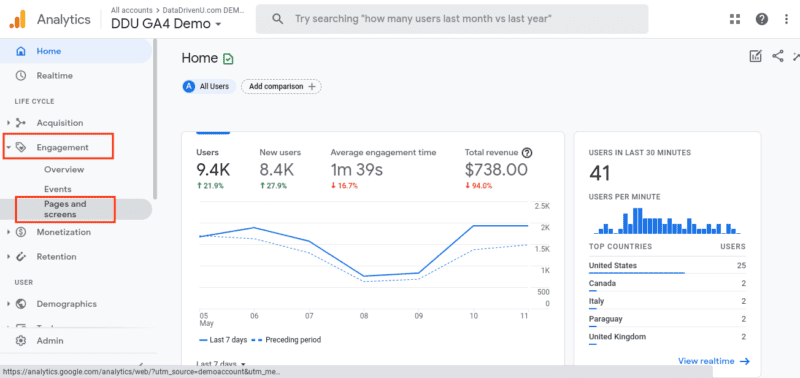
What It Is: Anytime a page loads for a user, it’s considered one pageview. Pageviews is a metric that measures the total amount of times a particular page is seen by visitors. While a single user may have multiple pageviews, when they visit 5 or more pages, it’s then referred to as a session. While UA used to track web and app page views separately, GA4 now combines both statistics together.
What It Means: Pageviews are the perfect metric for deciphering what’s popular on your website. It shows which pages are resonating with users and which pages might be getting lost in the shuffle.
Tip: There are certain pages that you can expect to receive fewer views than others—for instance, the “About Us” page. And that’s not really anything to be concerned about. BUT, if vital pages, such as your cart checkout page, your contact forms, or your newsletter subscription forms aren’t being found, then it’s time to take a look at your site and understand what’s going on beneath the surface, whether it’s loading difficulties, poor site architecture, or something else.
Final Thoughts
Honestly, Google’s metrics aren’t exactly easy to decipher, and with the latest GA4 changes, it’s understandable if you’re still having trouble keeping up with all of the changes.
Website metrics aren’t just about collecting data; they’re also about making informed decisions to drive business growth. With these insights, you can refine your social media strategy, optimize campaigns, and maximize your return on investment. Remember, in the world of websites, what gets measured gets managed, and what gets managed gets results.

If you’d like some extra help cutting through the madness, the team at Tangible is happy to lend a hand. We stay on top of the latest changes in website analytics so that you don’t have to, ensuring that your site is optimized at every turn. Contact us today to schedule your free consultation!
5 Reasons Why Yes, Yes, and YES It ABSOLUTELY Does
Non-profit work never sleeps. And it’s no wonder—your employees pour their heart, soul, blood, sweat, and tears into their work, trying their hardest to promote your organization to the best of their abilities.

But sometimes, in your quest to spread the word about your non-profit, it still feels like your marketing department is working on a makeshift dime and scrambling to find new ways to increase your outreach.
Let us tell you a not-so-secret secret.

If you’re still focusing the majority of your efforts on things like mailers, publications, media coverage, and social media, you’re missing out on one of the foremost marketing opportunities at your disposal—the blog.
While nearly 76% of non-profit organizations utilize content marketing methods, only 64% dare to maintain a blog on a regular basis. And we get it— it’s a lot of work!

Needless to say, blogs can help with lead generation and establish a voice of authority for your non-profit organization. Below, we’re breaking down some of the biggest reasons why you should consider creating a blog for your organization.
1. Establishes You as a Leader in Your Industry
One of the most essential aspects of any non-profit organization is the fact that, in and of itself, your organization is a resource to the public. Whether you’re a non-profit animal rescue or an emergency shelter for disaster relief victims, you provide resources that few other places provide in the community.
That also means you possess highly specific and valuable information that the public isn’t always aware of. Undoubtedly, the members of your team have an extensive wealth of knowledge collected from their time working at your organization—and what better thing to do than to make your website an extension of your team’s knowledge?

A blog adds credibility to your non-profit, which is extremely important, especially when trying to instill a sense of reputability and trust among potential donors. By establishing that you are a knowledgeable voice, the benefit is two-fold: you build a sense of trust in the public and provide them with a wealth of resources. And better yet? A blog can also help eliminate the stress of fielding questions from the public—just direct them to your online blog!)
2. Drives Donor Engagement and Support
A well-crafted blog can be a powerful tool for driving donor engagement and support for nonprofit organizations. Firstly, it allows nonprofits to share their mission, vision, and impact stories with a wider audience. By regularly publishing content that highlights the work you do and the difference you make, nonprofits can create a stronger emotional connection with their donors.

Personal stories of individuals or communities positively affected by your organization’s efforts can evoke empathy and inspire action. Donors want to know that their contributions are making a tangible difference, and a blog provides a platform to showcase these success stories, reinforcing their belief in the cause and encouraging continued support.
Secondly, blogs enable nonprofits to keep their supporters informed and engaged. Regular updates on ongoing projects, upcoming events, and organizational developments foster a sense of transparency and trust. Donors appreciate being in the loop and knowing that their contributions are being put to good use.
3. You Can Build a Base of Readers Whom You Can Track
Don’t get us wrong—we love a good newsletter, but… How can you tell if anyone’s actually reading it?

Spoiler alert: You can’t.

With a blog, you can actively see how many people are reading your material with trackable metrics that allow you to gauge your audience reach more easily. You can also see what’s attracting the most attention, allowing you to better hone your efforts into the campaigns that are garnering the biggest viewership. Plus, even if your audience doesn’t have quite as big a reach as press releases seem to, you’re catering to a loyal audience as opposed to painting with a broad stroke and hoping something sticks.
4. You Control the Narrative
Blogging is a form of journalism. Except, you are the journalist—no siphoning your information through other sources who ultimately end up watering your message down or muddling your message with misinformation or false narratives.

Blogging means you can deliver your message to the public exactly as you intend it. You can make that as complex, informative, and in-depth as you want to. Think of it as your platform to dispel rumors, debunk myths, and inform the public of what your actual views as an organization are.
Field your own press questions, write up your own releases, and be the source of news your donors would like to see.
5. Have the Space to Share Inspiring Stories
Social media is great, but rarely is it enough to tell a story in full detail—after all, most people’s attention spans are limited to 30-second clips and paragraph captions.

And let’s face it—a lot happens day-to-day working for a non-profit. Did you help to rehome a family whose house was destroyed in a recent flood? Did you rescue a dog from a horrible hoarding situation only to adopt it out to a loving family? Was a Thanksgiving Drive so inspirational that one of your donors chose to contribute a million dollars toward your organization?
Then give those stories the space they deserve! Consider social media like a trailer reel—sure, they have an idea of what happened, but it can’t capture the emotion and heartbreak of an entire story. Having a long-form blog to link to on those social media posts also attracts clicks to your site—where viewership matters most.
Perhaps those viewers will choose to stick around a bit longer and explore the rest of your site and would even like to contribute to your cause after reading your post. Without a blog, social media has no final destination. That is, it’s only a snippet of what your organization does. But, when your site has a blog, it ensures that people have a reason to come to your site and stick around on it for a bit longer than they intended to!
Final Thoughts
The power of blogging for nonprofit organizations cannot be overstated. From establishing credibility and trust to driving donor engagement and support, a well-maintained blog can be a game-changer in your outreach efforts. It serves as a platform to share your mission, vision, and success stories, connecting with your audience on a deeper level and inspiring action.
Moreover, a blog provides valuable insights into your readership, allowing you to track engagement and tailor your content to their interests effectively. You control the narrative, ensuring your message reaches the public as intended, free from external filters or misinterpretations.
Plus, it also gives you the space to share the inspiring, heartwarming stories that define your organization’s impact. It complements your social media efforts by offering a deeper dive into your work, attracting visitors to your site, and providing them with a reason to stay and support your cause.
While we could sugarcoat the truth, managing a blog is time-consuming and challenging (we’re taking some time off to recover from writing this one). That being said, the rewards of creating your own blog are immeasurable.

If you’re ready to harness the full potential of blogging but need assistance, Tangible is here to help. We specialize in creating and managing blogs that amplify your voice, engage your audience, and drive support for your nonprofit.
Interested to learn more about how we can help? We love working for organizations with a higher cause—let’s chat!
We hate to burst your bubble, but… being pretty simply isn’t enough in the age of digital domination where user experience reigns supreme.

In today’s day and age, users simply demand more from websites than pretty graphics and flashy animations—they demand a seamless, hassle-free experience where they can intuitively find and get exactly what they need.
Ever clicked on a website and thought, “Did a toddler design this when they were coming down from a Peppa Pig sugar bender?”

Trust us; you’re not alone. It’s 2023, and if your website still feels like it belongs in the era of dial-up connections and floppy disks, it’s high time for a revamp. Or, um… Scratch that. Maybe, it’s time to simply polish that up, call it nostalgia, and market it to the youth?

However, the original point still stands. If users can’t find the information they need, what’s to stop them from clicking off your site and onto the 2 billion plus other competitors one away?
Is your site optimized for aesthetics, or is it actually designed for the very people it’s meant to serve?
Let’s look at some of the smartest ways to incorporate intuitive design into your website.
What Is Intuitive Design?
Intuitive design isn’t just a fancy term thrown around by bespectacled tech hipsters sipping overpriced organic soy lattes. It’s the secret sauce distinguishing between a website that feels like a sleek, luxury sedan and one that looks like the Yale School of Art.
Imagine handing Shakespeare a smartphone and expecting him to order a pizza. Sounds like a bad 90s rom-com starring Gwyneth Paltrow, right?

Intuitive design ensures that even old Will wouldn’t be left hungry. It’s about making your website so simple and instinctive that you can glide through without a hiccup whether you’re 5 or 95, tech-savvy or tech-averse. No confusion, no “where-the-heck-do-I-click-now” moments. It’s the digital equivalent of walking into a room and instinctively knowing where the light switch is.
Intuitive website design is all about creating an online experience that feels second nature to the user. This means prioritizing simplicity and clarity, ensuring that navigation menus are easy to find and understand and that content is structured logically. It’s about predicting the user’s needs and serving up the most relevant information or functionality right when they need it.
Elements like consistent color schemes, familiar icons, and recognizable patterns all play a role. The goal is to eliminate any friction or confusion, making the user’s journey from point A to point B feel like a breeze. When done right, intuitive design ensures that the user spends less time deciphering the website and more time engaging with its content or completing desired actions.
The 8 Characteristics of Intuitive Design
Eight pivotal attributes that help define intuitive design include:
- Simplicity: Ditch the fluff. In the age of the 8-second attention span, no one’s got time for a cluttered mess. Make it clean, make it fast.
- Consistency: Don’t make users play guessing games. Whether it’s a button or a color scheme, uniformity is crucial.
- Familiarity: Icons should be recognizable, not abstract art. A cart should scream “Buy,” not “What’s this?”
- Clarity: Speak human. If users need a dictionary or a tech guru by their side, you’re doing it wrong. Besides, no one likes to speak to IT people. No one. Need we give you more proof as to why?
- Feedback: People aren’t psychic. If they click something, they want to know what’s happening. Now.
- Flexibility: Not everyone surfs the web the same way. Design for the masses but allow for some mavericks.
- Efficiency: The fewer steps, the better. If your site feels like a labyrinth, users will head for the exit.
- Error Tolerance: Oops! Everyone screws up. Instead of a cold error message, hand them a digital roadmap back to sanity.
Bottom line? An intuitive design shouldn’t feel like a brain workout. Let users glide, not stumble.
Why Should Companies Opt for Intuitive Design?
If you can’t find a way to make it from your homepage to the checkout page in less than a minute, then it’s time to rethink your entire design. In this day and age, time is a commodity, and the internet has been trained to have an attention span the size of a TikTok video. The faster, easier, and more intuitive your design, the better the overall experience for your users and the less headache for your brand in the long run.
And besides, a simpler site doesn’t always equate to a stupider site. In fact, sometimes simple is much, much better when it comes to web design.

So let’s break down a few of the most important rules your site should follow.
Ain’t Nobody Got Time for That!
Consider Tik Tok the Pavlov of its time, conditioning users to anticipate immediate laughs, insight, or pleasure in the span of 60 seconds or less. They expect no less from their website. If users can’t find what they’re looking for in seconds, they’ll bounce faster than you did that time your Hinge date asked if you wanted to see how hard he could rev his Prius.

An intuitively designed website ensures that users don’t need a roadmap, a compass, or a seasoned sherpa to navigate to the exact destination they intend to visit—so having the right signifiers, icons, and website copy to guide users to their destination spot should come first and foremost before any other considerations.
First Impressions Matter. Like, a Lot
Remember that time you photo-dumped every drunk shot from your wild night out for, like, your entire college career? Yeah. Your employer didn’t. And on a side note, maybe that’s why millennials can’t afford housing?

Similarly, your website is often the first impression people have of your company. So don’t dump every ounce of your design knowledge you have onto the landing page.
An intuitive design should be simple, clean, and easy to navigate. A messy, overdone site either wreaks of a design agency going buck wild on their home page or suggests an inexperienced company unworthy of a user’s trust.
Reduced Tech Support Nightmares
Intuitive design isn’t just about looking good; it’s also about functioning seamlessly. No one wants to dial a helpline just to locate the “Contact Us” page. Making your page simple and easy to find human help when a user needs it most is one of the most critical things you can do for your site.
After all, the last thing you want is your eating disorder chatbot to help your clients by telling them to eat fewer calories… which is sadly a very true story.

And on that note, you should also resist the urge to over-automate. While Chat GPT and artificial intelligence can undoubtedly help direct customers to helpful advice or information, it’s still no substitute for a live human being on the other line.
Increased Conversion Rates
An easy-to-navigate site keeps visitors longer and makes them more likely to convert– be it signing up for a newsletter or making a purchase. Do you want your user’s journey to feel like a stroll in the park or a trek through the Amazon jungle with a broken compass?

It’s Cost-Effective in the Long Run
Think of intuitive design as a one-time investment that will pay off dividends in the future. Fewer redesigns, fewer customer support woes, and a significant drop in potential clients clicking away in frustration all translate to more pennies in your pocket.
Final Thoughts
To wrap this up, if you’re still on the fence about intuitive design, consider this: the digital realm is a brutal, unforgiving landscape. Sites that don’t adapt (read: aren’t user-friendly) get left behind.
So, unless you want your website to be a relic of a bygone era, discussed in hushed tones like the fact that you voted for Kanye for president before you realized you were really just encouraging an antisemite’s mental breakdown, then it’s high time you embrace intuitive design.

In the world of web design, remember: it’s survival of the fittest. Or, in this case, survival of the slickest. So if you’re looking for an extra hand to optimize your site design, the team at Tangible is ready to whip your site into tip-top shape.
So don’t be shy and go ‘head girl, go head get down… into our DMs.
…yeah, too soon.
We all remember that one kid who would show up late to class, ask his buddies for copies of their notes, forget to study for any test, and somehow ace the semester with ease, gliding his way into Ivy League collegiate glory. Maybe, this person was an albatross of sorts— a foreboding sign to you that life has never been and will never be fair.

Well, welcome to the real world, kid. And you’re living in the darkest timeline where two spoiled, self-entitled billionaires that were never taught the currency of empathy battle it out to determine which one has the larger— well, uh… let’s just say the larger amount of generational trauma between them.

One billionaire destroys a middling form of social media while the other copies his homework and claims it as his own. Does anyone really win in this story?

Welcome to Threads, the app that no one asked for or wanted. Do you like Twitter?
Then how would you like a second Twitter where you can do the exact same thing as the other Twitter, only different?

Instead of Tweeting, you can reap what you SewTM!
Instead of shitposting, you can shitpost harder!
And instead of 2.5-minute long videos— you can post a whole 5 minutes worth of short-form videos (that’s almost an entire Tubi episode!)!
Like lemmings, we all jumped aboard the freight train that was the release of Threads— but is this platform that’s enough to make Kendall Roy’s Living+ facility look like a work of genius doomed to fall off a cliff, or are we simply doomed to doomscroll our lives into the abyss that is an antisocial billionaire’s nightmarish version of social connection?

Is Threads even worth bothering with, or is it ultimately bound to go the way of apps like Google+, Vine, YikYak, and MySpace? Because, my friends, there’s only so much room left to mourn the digital world’s latest victims (and we’re still coping with the loss of MySpace and Xanga, TBH).
Let’s unpack what the latest launch of Zuckerburg’s copycat Twitter app means for your business and if it’s even worth considering as a comprehensive part of your social media strategy.
What is Threads?
Threads is like that telephone game you used to play when you were a child— one person whispers a phrase into your ear, and then you pass it down the line until the phrase “hot crossed buns see how they run” becomes “pot flossed runs, three cows love guns.” Only this time, one millionaire took another millionaire’s web developers and had them recreate an app using similar code.
Threads, according to Threads, is an app “built by the Instagram team for sharing text updates and joining public conversations. You can log into it using your Instagram account, and posts can be up to 500 characters long and include links, photos, and videos up to 5 minutes in length.”
So… yeah. It’s basically just Twitter but with slightly lengthier features. As of yet, Threads’ creators haven’t implemented (or shall we say, “figured out how to replicate”) the “follow” feature, so unlike Twitter, there isn’t a curated news feed comprised of a user’s followers.

Regardless, Threads has yet to offer a unique value proposition for its users that’s different from anything that Twitter currently offers, and according to Fortune.com, it’s also lost half of its active users in less than a week since its media-blitzkrieg of a launch. And in case you didn’t know, a Threads account cannot truly be deleted unless one deletes their entire Instagram account (only deactivated)… so any statistics Meta wishes to publicize may be prone to manipulation. Which Meta would never do, would they…?

Without a clear reason for existing other than a billionaire’s personal quest to troll a fellow troll (game recognizes game, Musky), Threads’ entire viability truly hangs in the balance of whether or not the Zuck chooses to differentiate it in some way, shape, or form from Twitter.
Otherwise, other than ego, greed, and mommy issues… why?

How Can Threads Benefit Small Businesses?
So before you sell everything and pack up your Twitter bags to migrate all of your threads over to Threads, take a deep breath, sit back, and relax a bit. Currently, your best bet is to see how this whole thing plays out.

Besides, it’s not like Instagram didn’t already kill off an app called Threads a few years ago, anyway… so maybe it’s best to give that app some grieving time before jumping into a new one (out of respect for the victim).
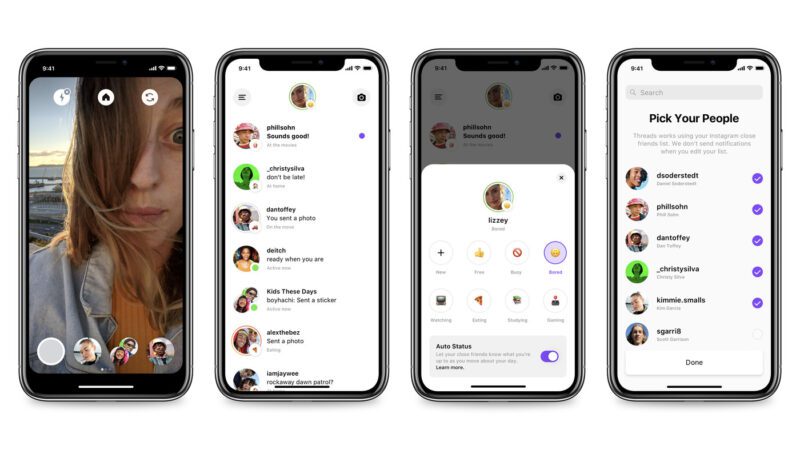
And speaking of past failures, Facebook has had its own set of failed endeavors too, starting with the horror show that was their dating app (a truly terrifying experience for any woman) and their brief foray into mobile-tainment programming that was “Facebook Watch.”

Despite the early fuss over Threads, it’s too soon to tell if the app truly has any staying power. After all, it’s such a carbon copy of Twitter that there’s no clear advantage to using the app at the current moment.
However, that doesn’t mean that things won’t change. The one thing that Meta succeeds at that Twitter doesn’t is paid advertising and cross-platform integration. So, don’t discount the fact that users may find it easier to post on Threads through future integrations via Facebook or Instagram. And don’t discount the fact that paid advertising and catering to marketers may be a future game changer for Threads one day.
Will Social Media Fatigue Kill Threads?
Fads wear thin. And we all know the internet has the memory of a clownfish when it comes to keeping track of things they’ve canceled, so who knows how long people will rebel against Elon’s ownership of Twitter (because, at the core, that seems to be what Threads is hoping to monopolize on). Being a giant media conglomerate also isn’t proof of success; it’s simply proof that a platform has substantial financial backing. Can you say “Google Plus,” “Amazon Fire Phone,” or “Tubi”?
While users want to be entertained, do any of us still have the mental capacity for an app that brings nothing new or novel to the table? More importantly, do marketers want to invest in yet another social media platform when they’re already stretched thin amongst the spread of TikTok, Instagram, YouTube, Twitter, LinkedIn, and Facebook?

Perhaps if Threads can find a way to implement paid advertising in a way that Twitter can’t, it may prove more enticing and offer some faint glimmer of monetizable value. But for now, it’s just kind of there. And honestly, there’s better programming on Twitter already.
Should I Create a Threads Account for My Business?
While there’s certainly no harm in creating a Threads account, there’s also no grand reason at the moment to invest too much time or effort into it. At least, not until Threads develops into something that is in some way, shape, or form distinguishable from Twitter.
In other words, keep one eye open, don’t sleep on it, but don’t fret about it too much, either. If Twitter is your main platform, then it’s wise to go ahead and invest in a Threads account. But if Twitter isn’t your social platform of choice, then Threads probably won’t offer you much ROI at the moment.
If you do choose to create a Threads account, then at the very least, have something to say and find subtle ways to differentiate it from your Twitter account; otherwise, what’s the point?
Consider airing the short-form content that’s too long to put on TikTok, Instagram, or Twitter on your Threads account. And make sure, above all else, that you’re there to entertain, educate, or offer a unique viewpoint that your audience can’t find anywhere else.
Final Thoughts
So to all of the teachers who taught us millennials that plagiarism never pays off… Mark Zuckerberg would beg to differ.

And if you, dear reader, just like the rest of every marketer out there, are simply too tired to deal with yet another digital void we like to call social media, then welcome to the club!
But in the meantime, if you’d like to dip your toes into the world of Threads, we’re here to help you devise a strategy that works best without spreading your resources too thin.
So if you’re ready to be plugged into the wubbulous world of Mark Zuckerberg’s Metaverse, we’ll make sure we slip you that blue pill so you’ll never have to live a day without going unplugged.

To talk shop and create a strategy best suited to your business’s objectives, schedule a free consultation with our marketing team.